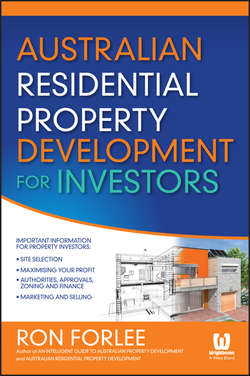Australian Residential Property Development for Investors

Реклама. ООО «ЛитРес», ИНН: 7719571260.
Оглавление
Forlee Ron. Australian Residential Property Development for Investors
About the author
Acknowledgements
Preface
CHAPTER 1. An overview of property development
The role of a property developer
Types of property developers
Residential versus commercial developments
Types of residential developments
Types of commercial developments
Benefits and risks in property development
Summary
CHAPTER 2. Characteristics of a successful developer
What makes a successful developer
Understanding the market
The importance of research
Build a business network
Reading property market cycles
Opportunities in development
Summary
CHAPTER 3. The development process and participants
The process
The participants
Roles of developer and participants
Summary
CHAPTER 4. Development site selection
Factors that make a good development site
Reviewing established buildings
Analyse the economic characteristics
Analysing the property market trends
Avoiding legal pitfalls
Assembling several properties for development
Summary
Development site checklist
CHAPTER 5. Negotiation and purchasing
Structuring your offer
Position yourself for negotiations
Prepare a pre-purchase feasibility report
Items to consider before making an offer
Tendering for a development site
Securing development rights
Securing an option
Summary
CHAPTER 6. Making the numbers work
Preparing a cost and income spreadsheet
Preparing a prefeasibility analysis
Preparing a monthly cash flow
Sensitivity analysis
Refinement process
Other financial and measurement calculations
Summary
Income and expenditure checklist
CHAPTER 7. Development economics
What is development economics?
The influence of site selection on cost
The influence of design on building cost
The influence of construction methods on cost
The influence of contractors on development cost
The influence of finance on development cost
The influence of authorities on development cost
When plans exceed the budget
Summary
CHAPTER 8. Utilising modern technology
Modern technology in property development
Using the internet for market research
Using the internet for property information
Software for feasibility studies
Communicating with the development team
Using modern technology for marketing
New construction methods in development
Summary
CHAPTER 9. Raising development finance
The lenders
Types of development loans
Loan characteristics
Packaging a loan proposal
How a lender evaluates a development loan
Negotiating loan document details
Using finance brokers
Summary
CHAPTER 10. Raising equity finance
What is equity?
What is sweat equity?
Equity through the landowner
Dealing with an equity partner
Preparing an investor information package
Guide to raising equity
Increasing your equity in a staged process
Summary
CHAPTER 11. The development approval process
The DA process
Step 1: Legal due diligence
Step 2: Site information
Step 3: Market research
Step 4: Creating the development brief
Step 5: Development team selection
Step 6: Development approval budgeting
Step 7: Programming work tasks
Step 8: Master planning and architectural design
Step 9: Feasibility study
Step 10: Preliminary development finance
Step 11: Development approval application
Summary
CHAPTER 12. The construction process
The role and responsibilities of a contractor
Types of contractors
Contractor selection criteria
Understanding building contracts
Tender phase
Construction phase
Summary
CHAPTER 13. Marketing and selling
Understanding the residential market
Marketing yourself as a developer
A developer's approach to marketing
Selling off plan strategy
Summary
CHAPTER 14. Residential land development
Benefits in land development
Risks in land development
Development strategies
Role of the land developer
Land development process
Market demand
Analysing the location
Analysing the market
The development team
Planning considerations
Development cost
Sourcing finance
Authorities and approvals
Marketing and sales
Summary
Case study
CHAPTER 15. Villas and townhouses
Definitions
Benefits and risks
Demand for unit-type living
Development strategies
Location
Site analysis
Market profile
Market analysis
Development team
Design considerations
Cost factors
Finance
Contracts
Marketing
Strata title
Summary
Case study
CHAPTER 16. Apartment developments
Types of apartments
Types of apartment units
Demand for apartment living
Advantages, disadvantages and challenges
Selecting the project type and site
Role of the developer
Buyer profile
Design and planning aspects
Apartment development principles
Summary
Case study
Conclusion
Advantages of investing
Advantages of developing
The decision
Index
Отрывок из книги
Ron Forlee is an architect, developer and author. He is also the Managing Director of AYR International Pty Ltd, an international development management company and Archiplan Pty Ltd, an Australian-based architectural practice.
Over the past 37 years Ron has been involved in a range of property developments, from housing estates, to hotels, to shopping centres, which he has managed and financed. As an architect he has master-planned large-scale communities and infrastructure projects and designed commercial buildings such as shopping centres, office blocks and tourism developments in Australia, South Africa and China.
.....
• conference centres.
Educational facilities can vary from private primary schools to tertiary centres such as colleges and universities with adjacent science technology parks. Categories include:
.....